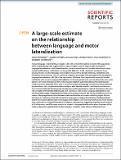A large-scale estimate on the relationship between language and motor lateralization
Abstract
Human language is dominantly processed in the left cerebral hemisphere in most of the population. While several studies have suggested that there are higher rates of atypical right-hemispheric language lateralization in left-/mixed-handers, an accurate estimate of this association from a large sample is still missing. In this study, we comprised data from 1,554 individuals sampled in three previous studies in which language lateralization measured via dichotic listening, handedness and footedness were assessed. Overall, we found a right ear advantage indicating typical left-hemispheric language lateralization in 82.1% of the participants. While we found significantly more left-handed individuals with atypical language lateralization on the categorical level, we only detected a very weak positive correlation between dichotic listening lateralization quotients (LQs) and handedness LQs using continuous measures. Here, only 0.4% of the variance in language lateralization were explained by handedness. We complemented these analyses with Bayesian statistics and found no evidence in favor of the hypothesis that language lateralization and handedness are related. Footedness LQs were not correlated with dichotic listening LQs, but individuals with atypical language lateralization also exhibited higher rates of atypical footedness on the categorical level. We also found differences in the extent of language lateralization between males and females with males exhibiting higher dichotic listening LQs indicating more left-hemispheric language processing. Overall, these findings indicate that the direct associations between language lateralization and motor asymmetries are much weaker than previously assumed with Bayesian correlation analyses even suggesting that they do not exist at all. Furthermore, sex differences seem to be present in language lateralization when the power of the study is adequate suggesting that endocrinological processes might influence this phenotype.
Citation
Packheiser , J , Schmitz , J , Arning , L , Beste , C , Güntürkün , O & Ocklenburg , S 2020 , ' A large-scale estimate on the relationship between language and motor lateralization ' , Scientific Reports , vol. 10 , 13027 . https://doi.org/10.1038/s41598-020-70057-3
Publication
Scientific Reports
Status
Peer reviewed
ISSN
2045-2322Type
Journal article
Description
This study was supported by grants of the Deutsche Forschungsgemeinschaft (GU227/16-1; BE4045/26-1) as well as through the DFG Research Training Group “Situated Cognition” (GRK 2185/1). This study was also supported by the Ruhr University Bochum Cutting-Edge grant. We acknowledge support by the DFG Open Access Funds of the Ruhr-Universität Bochum.Collections
Items in the St Andrews Research Repository are protected by copyright, with all rights reserved, unless otherwise indicated.

